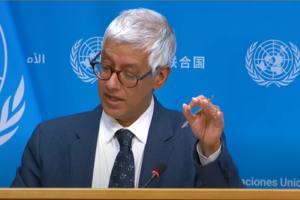Media Bias Alert: Media Split on Significance of Energy Department's Lab Leak Theory

Each week, AllSides Media Bias Alerts examine media bias in coverage of a major or important story using the AllSides Media Bias Ratings™ and our AllSides Media Bias Chart™.
The U.S. Department of Energy's (DOE) conclusion that the COVID-19 pandemic was most likely the result of a lab leak in Wuhan, China adds to continued debate among scientists and intel groups about the pandemic’s origins.
To no surprise, the story received fairly wide coverage from media across the spectrum, particularly from sources with an AllSides Media Bias Rating™ on the right, which featured their coverage of the story more prominently.
Some were explicit about important context, ie: low vs medium confidence conclusions
The DOE presented its findings in a classified intelligence report to key lawmakers last month, according to The Wall Street Journal (Center bias).
There is significant divide among intel groups about COVID-19's origins. Currently, the DOE has “low confidence” in the conclusion, while its contemporaries at the FBI have “moderate confidence” in it. The National Intelligence Council and several other unnamed U.S. intelligence agencies have arrived at “low confidence” conclusions that the virus most likely emerged through natural transmission. Others, including the CIA, remain undecided.
RELATED: Misinformation Watch: Did COVID-19 Leak From a Chinese Lab?
The DOE has an Office of Intelligence and Counterintelligence, one of 18 government departments that make up the U.S. intelligence community. The department also oversees 17 labs, some of which conduct biological research.
Many right-rated outlets covered the story more emphatically, and seem more apt to believe the conclusion is an important development in the now three-year-long pursuit of COVID-19’s origins.
The Washington Examiner (Lean Right bias), National Review (Right bias), and others highlighted how FBI Director Christopher Wray said this week that the lab leak theory was the “most likely” origin of COVID-19.
The Daily Wire (Right bias), The Washington Times (Lean Right bias), and others highlighted China’s response to the news, and framed its government as defensive.
Fox News (Right bias) published an article criticizing the New York Times (Lean Left bias) for being “among the many media organizations in 2020 that pushed the narrative that the COVID lab leak theory was some sort of wild conspiracy being pushed by the far right.”
Fox News TV host Tucker Carlson (Right bias) highlighted the surety with which many left-rated outlets called the lab leak theory a conspiracy in the past. He also highlighted that left-rated outlets and Chinese state media both suggested that Republican President Donald Trump’s use of the term “China Virus” had racist roots, on the basis that the lab leak theory was certainly false.
While the recollections of media coverage are true, Carlson did not mention that there are four other intelligence agencies who still hold conclusions that COVID-19 occurred naturally. He neglected to emphasize the “low confidence” rating of the DOE’s findings. Respectively, these are examples of bias by omission and spin. Carlson is an opinion commentator, and his content shouldn’t be interpreted as news.
Right-rated media’s emphasis on the DOE’s findings conveys the belief that further questioning and discussion of COVID-19’s origins is needed.
Left-rated outlets downplayed the results more, often emphasizing the “low confidence” of the report, and omitting the “low confidence” ratings of other agencies’ conclusions that the virus originated via natural transmission. This double standard can also be seen as a type of bias by omission.
A Politico (Lean Left bias) article said that “Congressional Republicans are anxious to use new COVID-19 lab leak reports to lash out at the ruling Chinese Communist Party and paint President Joe Biden’s administration as soft on Beijing.”
The Associated Press (Lean Left bias) published an article purporting that “any new report on the virus’ origin quickly triggers a relapse and a return of misleading claims about the virus, vaccines and masks that have reverberated since the pandemic began.”
The Washington Post (Lean Left) published a headline, “Little-known scientific team behind new assessment on COVID-19 origins”. “Little-known” seems to cast doubt on the authoritativeness of the team and includes the use of a subjective qualifying adjective. The article states that the team “conducts some of the federal government’s most secretive and technically challenging investigations of emerging security threats.” The headline doesn't mention who the scientific team is “little-known” to, yet the use of the word “secretive” implies why the team investigating a classified matter would be "little-known" to the American public.
While coverage was largely polarized and contained different emphases, some outlets included key context that readers may have expected to see in outlets on the opposite side of the spectrum.
For instance, Washington Examiner (Lean Right) was explicit in labeling the DOE’s conclusion as “low confidence,” and The New York Times pointed out that the four agencies that reached the conclusion of spread through natural transmission did so with “low confidence,” as well.
Insider (Lean Left bias) published a headline saying, “China spent years angrily trying to shut down the theory that COVID-19 came from its labs. It failed.”
Due to the significance of the COVID-19 pandemic and its global effects, the DOE’s shift in stance is a newsworthy story.
Readers should understand that most journalists only have a limited understanding of what these developments mean, and should stay vigilant in looking for bias on this highly polarized matter. Consider that not every new development will be binary in significance as a nothingburger or a smoking gun.
For more analysis of biased news coverage on important stories, keep up with our Media Bias Alerts. Recently, we’ve also analyzed bias in coverage of right-rated media ignoring Fox News election lawsuit claims.
Andy Gorel is a News Curator at AllSides. He has a Center bias.
This piece was reviewed by Managing Editor Henry A. Brechter (Center bias), Daily News Editor Joseph Ratliff (Lean Left bias) and Julie Mastrine, Director of Marketing and Media Bias Ratings (Lean Right bias).


May 16th, 2024

May 16th, 2024

May 16th, 2024